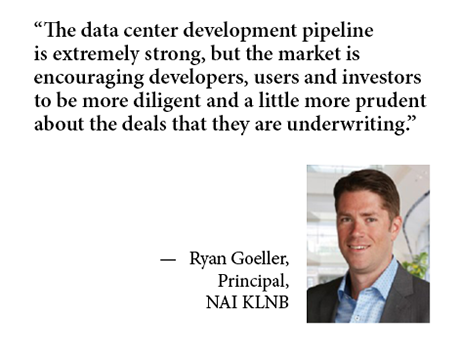The data center market remains a powerhouse of growth and demand in the commercial real estate world. REBusinessOnline sat down with Ryan Goeller, a principal at NAI KLNB commercial real estate services in Virginia, to discuss the various factors impacting this dynamic asset class.
REBusinessOnline: Briefly, a data center is a dedicated building housing computer servers and storage systems, constantly processing and managing data for various applications. What is the current state of the data center market?
Goeller: Extremely active, with very high demand. Development pipelines are at full power and are strained in certain markets. Leasing demand is through the roof.
REBusinessOnline: What types of tenants use these data centers, and what are their space needs?
Goeller: The majority of the time, the need for space is so insatiable that entire buildings are leased to single users, especially when it comes to large hyperscale computing projects. However, there are still colocation providers housing smaller tenants in certain buildings.
A lot of the activity happening in Northern Virginia is hyperscale activity. These are large tech companies coming in and building 2-million-square-foot campuses that they’re fully occupying themselves. In these instances, the tenants aren’t likely to move once they occupy a space; they’re just going to upgrade their equipment.
REBusinessOnline: How are investors navigating the current market conditions?
Goeller: Interest rate increases are affecting every sector of real estate. However, in the data center world, things are still moving because the demand is so high.
To address the market at large: high rates have adjusted investors’ expectations on returns and developers’ outlooks on project yields. The current conditions have taken some groups out of the market temporarily, just until interest rates level off — not even necessarily go down but level off. There’s some concern for certain investors that, when they enter into a deal on paper, by the time they get through entitlements, building permits and actually get the lease started, they could be 18 to 24 months along. If interest rates have moved 100 basis points in that timeframe, it could certainly affect a deal that initially seemed appealing when they signed the paperwork.
However, I don’t think these conditions are causing much of a slowdown in the data world. The data center development pipeline is extremely strong, but the market is encouraging developers, users and investors to be more diligent and a little more prudent about the deals that they are underwriting.
REBusinessOnline: What about issues related to water and power for data centers?
Goeller: Power is a significant issue. Developers plan for power at full capacity when getting a development approved.
Northern Virginia is going through some growing pains right now, where the infrastructure really hasn’t been able to keep up with the demand for power. The utility companies are in the middle of upgrading all their infrastructure to accommodate current development. Future development has been delayed while the region waits for new infrastructure.
Water, on the other hand, is becoming less of a concern in certain sectors, especially with the trend towards air-cooled data centers.
REBusinessOnline: How much of the development for data centers involves ground-up construction, and what are the trends in repurposing existing buildings?
Goeller: While greenfield development has been predominant, there is a recent trend towards redevelopment opportunities, especially in areas where land availability is becoming more constrained and as requirements for data centers have necessitated larger and larger swaths of land.
We’re seeing older flex parks, sometimes older office buildings that weren’t used very efficiently on the land, being repurposed. There are now some significant redevelopment projects underway due to the growing scarcity of land in Loudon, Prince William and, to some extent, Fairfax County VA.
Repurposing existing buildings, like older office spaces, is possible but more often the process requires a complete teardown and rebuild. When it comes to repurposing, a lot depends on whether there’s other land available and whether the underlying zoning will allow you to take the building down and put something else instead.
REBusinessOnline: What role do emerging technologies play in the data center industry?
Goeller: These new technologies — 5G, cloud storage, etc. — contribute to the overall growth in data center needs, but currently, the artificial intelligence (AI) sector is the biggest trend. AI requires massive computing power, leading to larger developments and an increased demand for space.
REBusinessOnline: What sorts of geographic trends in data center development are you seeing nationwide?
Goeller: Northern Virginia remains the largest data center market globally, but other cities are gaining traction due to factors like cheaper land prices and power availability.
REBusinessOnline: What advice would you give to investors looking to enter the data center market?
Goeller: Recognize that it’s a niche asset class and a somewhat finicky one. Seek guidance from someone with experience in data centers, as due diligence should include a focus on power, zoning and fiber availability (is the fiber available sufficient, can it be added to the site, etc.).
Data centers are extremely capital-intensive endeavors. While the land might seem expensive, it’s only a fraction of the overall development cost, which can run into billions. Caution and diligence in underwriting deals are crucial in this dynamic and fast-paced market.
This article was written in conjunction with NAI Global, a content partner of REBusinessOnline. For more articles from and news about NAI Global, click here.


